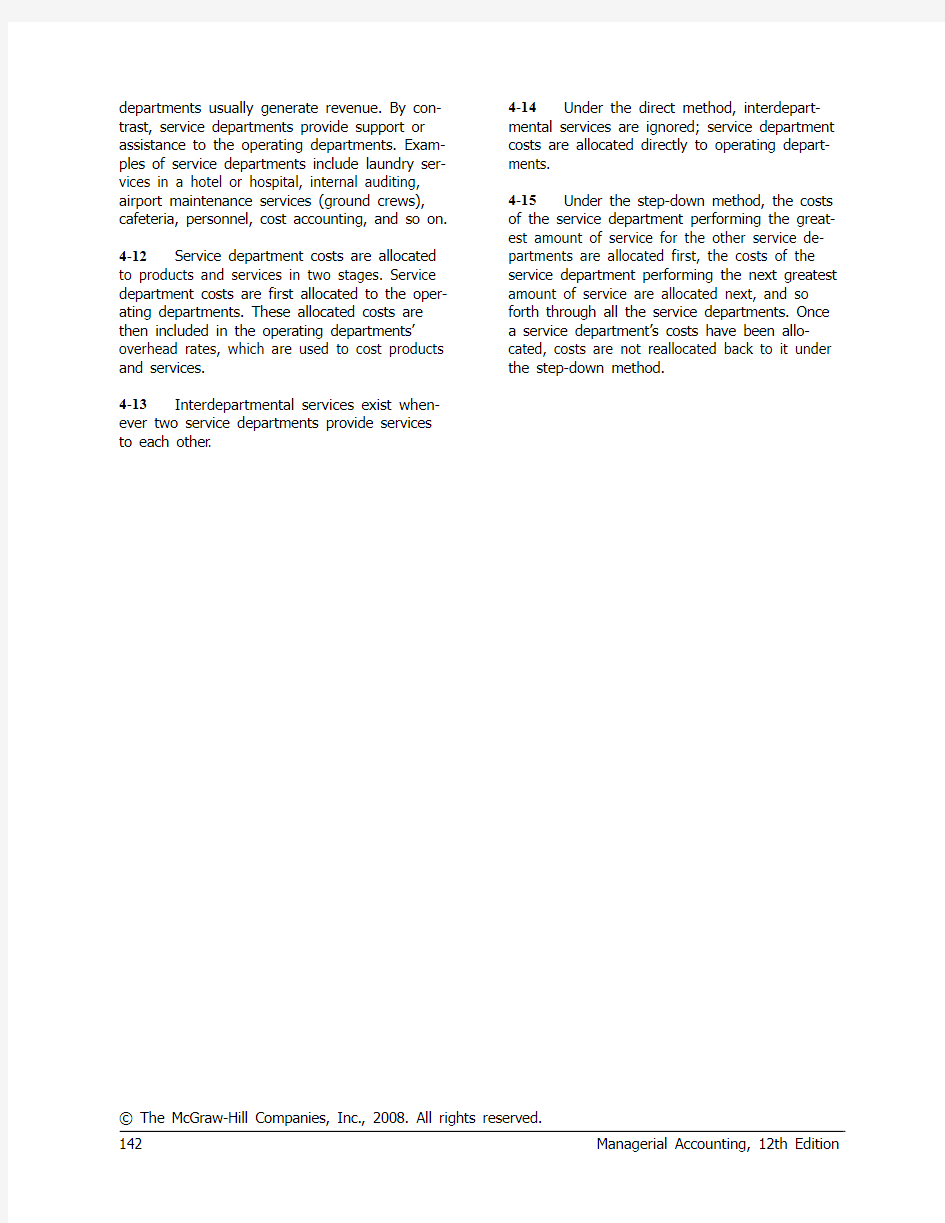Chapter-4-Solutions-Managerial-Accounting-12e-Garrison-Noreen-Brewer


Chapter 4
Systems Design: Process Costing Solutions to Questions
4-1 A process costing system should be used in situations where a homogeneous prod-uct is produced on a continuous basis.
4-2
1.Job-order costing and process costing have
the same basic purposes—to assign materi-
als, labor, and overhead cost to products
and to provide a mechanism for computing
unit product costs.
2.Both systems use the same basic manufac-
turing accounts.
3.Costs flow through the accounts in basically
the same way in both systems.
4-3Cost accumulation is simpler under process costing because costs only need to be assigned to departments—not separate jobs. A company usually has a small number of process-ing departments, whereas a job-order costing system often must keep track of the costs of hundreds or even thousands of jobs.
4-4In a process costing system, a Work in Process account is maintained for each separate processing department.
4-5The journal entry would be:
Work in Process, Firing........XXXX
Work in Process, Mixing.XXXX
4-6The costs that might be added in the Firing Department include: (1) costs transferred in from the Mixing Department; (2) materials costs added in the Firing Department; (3) labor costs added in the Firing Department; and (4) overhead costs added in the Firing Department. 4-7Under the weighted-average method, equivalent units of production consist of units transferred to the next department (or to fin-ished goods) during the period plus the equiva-lent units in the department’s ending work in process inventory.
4-8The company will want to distinguish between the costs of the metals used to make the medallions, but the medals are otherwise identical and go through the same production processes. Thus, operation costing is ideally suited for the company’s needs.
4-9Under the weighted-average method, each unit transferred out of the department is counted as one equivalent unit—regardless of in what period the work was done to complete the units. Under the FIFO method, only the work done in the current period is counted. Units transferred out are divided into two parts. One part consists of the units in the beginning inven-tory. Only the work needed to complete these units is shown as part of the equivalent units for the current period. The other part of the units transferred out consists of the units started and completed during the current period.
4-10The weighted-average method mixes costs from the current period with costs from the prior period. Thus, under the weighted-average method, the department’s apparent performance in the current period is influenced to some extent by what happened in a prior pe-riod. In contrast, the FIFO method cleanly sepa-rates the costs and work of the current period from those of the prior period. This makes the FIFO method superior to the weighted-average method for cost control because current per-formance should be measured in relation to costs of the current period only.
4-11Operating departments are the units in an organization within which the central pur-poses of the organization are carried out; these
? The McGraw-Hill Companies, Inc., 2008. All rights reserved.
departments usually generate revenue. By con-trast, service departments provide support or assistance to the operating departments. Exam-ples of service departments include laundry ser-vices in a hotel or hospital, internal auditing, airport maintenance services (ground crews), cafeteria, personnel, cost accounting, and so on.
4-12Service department costs are allocated to products and services in two stages. Service department costs are first allocated to the oper-ating departments. These allocated costs are then included in the operating departments’ overhead rates, which are used to cost products and services.
4-13Interdepartmental services exist when-ever two service departments provide services to each other. 4-14Under the direct method, interdepart-mental services are ignored; service department costs are allocated directly to operating depart-ments.
4-15Under the step-down method, the costs of the service department performing the great-est amount of service for the other service de-partments are allocated first, the costs of the service department performing the next greatest amount of service are allocated next, and so forth through all the service departments. Once a service department’s costs have been allo-cated, costs are not reallocated back to it under the step-down method.
? The McGraw-Hill Companies, Inc., 2008. All rights reserved.
Problem 4-23 (continued)
Computation of allocation rates:
Variable Food Services:
Variable food service cost$73,150
==$1.90 per meal Total meals served38,500 meals
Variable Admin. Services:
Variable administrative cost$6,800+$1,900
==$0.50 per file Files processed17,400 files
Variable X-Ray Services:
Variable X-ray cost$38,100+$950+$750
==$4.00 per X-ray X-rays taken9,950 X-rays
? The McGraw-Hill Companies, Inc., 2008. All rights reserved.
